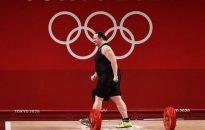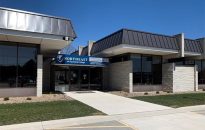The scene at the College Park sports complex was typical, filled with the vibrant energy of young competitors sharpening their abilities and challenging their boundaries. However, an ordinary volleyball practice took a tragic turn when a committed teenager, brimming with promise, unexpectedly collapsed on the court. The gym, previously alive with cheers and ambition, became […]

The scene at the College Park sports complex was typical, filled with the vibrant energy of young competitors sharpening their abilities and challenging their boundaries. However, an ordinary volleyball practice took a tragic turn when a committed teenager, brimming with promise, unexpectedly collapsed on the court. The gym, previously alive with cheers and ambition, became a haunting silence as teammates, coaches, and spectators grappled with the weight of the situation.
Those who witnessed the incident described it as surreal and profoundly disturbing. One teammate, clearly shaken, recalled how the teen had been participating in drills, showing no signs of any trouble just moments before. “We were all pushing ourselves, just like usual. Then she just fell. It was surreal,” stated the student, her voice laden with sorrow. The abruptness of the collapse left everyone dumbfounded, many unable to grasp how a young, seemingly fit athlete could suddenly face such a dire crisis.
Coaches and staff at the complex promptly mobilized, rushing to the teenager’s side in a frantic effort to assist her. While untrained witnesses felt powerless in the moment, staff quickly confirmed that first aid and basic life-saving measures were set in motion right away. Meanwhile, others swiftly contacted emergency services, hoping for a swift arrival. The atmosphere was thick with anxiety and dread as everyone held their breath, wishing for her recovery.
This heart-wrenching episode has elicited a swirl of emotions—bewilderment, sorrow, and a pervasive sense of disbelief. For those present that day and the extensive network of family and friends around the young athlete, the haunting images and sounds of her collapse are likely to endure. As initial shock transforms into concern and contemplation, many are asking direct questions about what could have led to this occurring to someone so vibrant and alive.
The emergency response was prompt, yet it highlighted the fragility of moments that can alter lives permanently. Reports indicate that 911 was dialed shortly after the teenager’s collapse. Those near the scene noted the urgency with which paramedics arrived, with sirens piercing through the previously calm atmosphere as help drew near. Time appeared to halt for everyone at the complex while the medical team acted swiftly to evaluate and stabilize the young athlete.
Officials have stated that paramedics began life-saving procedures immediately upon arrival, administering CPR and using an automated external defibrillator (AED). Their actions were both urgent and diligent as they worked relentlessly on the court, all while teammates, coaches, and bystanders observed in anxious silence. One mother, present to pick up her own child, remarked, “You could see their determination. They didn’t pause for even a moment. We were all just hoping they could save her.”
She was loaded into an ambulance and taken to a local hospital for further resuscitation attempts. The timeline between the moment of collapse and her transport to the hospital remains crucial, with emergency teams affirming it fell within the “golden hour,” vital for treating life-threatening situations. Despite their dedicated efforts, medical professionals were unable to revive the teen, and she was declared dead shortly after arriving at the hospital, leaving everyone involved grappling with the heartbreaking conclusion.
The swift actions of coaching staff and emergency responders have been widely commended, yet the lingering query of whether anything could have been done differently still resonates. Parents, schools, and sports organizations are beginning to evaluate the sufficiency of emergency preparedness during athletic events. Was an AED easily accessible when the collapse happened? Were coaches properly certified in CPR? These inquiries have sparked a larger discussion on the importance of preemptive safety measures in youth athletics.
This unfortunate event underscores the necessity of being equipped for medical emergencies in both public and private sports facilities. Incidents like this remind us that in environments where young athletes push themselves, the unforeseen can arise. Community leaders are advocating for increased CPR training and the installation of AED devices in all sports venues to better safeguard the lives of the young athletes who train there.
As the inquiry into the abrupt and tragic passing of the teen athlete proceeds, officials and medical specialists are collaborating to identify the cause behind this heart-wrenching matter. Initial reports have indicated that the young athlete showed no apparent signs of distress or concerning symptoms prior to her collapse, amplifying the urgency of understanding what could have resulted in such a heartbreaking situation. For her family, teammates, and the wider community, this quest for clarity is not just about closure; it’s about honoring her legacy and taking steps to avert similar tragedies.
Preliminary attempts to identify the cause of death have included a thorough examination of the athlete’s medical background, which her family has reportedly provided to investigators. Sources close to the investigation indicate she had been a vibrant and active teen with no known pre-existing conditions that could lead to sudden cardiac arrest or other life-threatening concerns. This deepens the uncertainty surrounding the event and highlights the complex nature of sudden medical emergencies, particularly in young athletes.
Authorities are awaiting the results of the autopsy to furnish more definitive information. The medical examiner’s office has confirmed that an exhaustive examination is in progress, including toxicology tests and heart analysis, in addition to checking for any latent issues that may have gone unnoticed. While conclusive results may take weeks, there is hope that the findings will reveal factors that could assist families, coaches, and healthcare providers in better protecting young athletes in the future.
Health professionals emphasize that sudden cardiac arrest (SCA) is a leading cause of unexpected death among athletes, even those otherwise considered healthy. Conditions like hypertrophic cardiomyopathy (HCM), often undiagnosed thickening of the heart muscle, or arrhythmogenic right ventricular cardiomyopathy (ARVC), a rare genetic disorder, are being weighed as potential reasons. Experts stress that these conditions are notoriously challenging to detect without specific screening tests like electrocardiograms (ECGs) or echocardiograms—tests that aren’t routinely mandated for youth athletes across many organizations.
Simultaneously with the medical inquiry, facility records and protocols are being scrutinized to ensure all safety measures were adhered to during the practice. Authorities are investigating whether the complex complied with emergency preparedness regulations, including the availability and functionality of AEDs (automated external defibrillators). Questions regarding whether the staff had recently completed CPR and emergency response training are also being examined as part of a broader audit of safety practices in athletic venues.
Dr. Emily Torres, a sports cardiologist who has extensively researched cardiac risks in student-athletes, notes that this tragedy underscores the vital necessity for preventive strategies, such as mandatory health screenings for all high school athletes, irrespective of their perceived fitness. “It’s a heartbreaking situation, but occurrences like this remind us of the imperative to be proactive rather than reactive,” Dr. Torres shared. “We owe it to our young athletes to develop systems that can identify such conditions before a devastating event like this transpires.”
As family and teammates await answers, the tragedy has initiated calls for reform within the community. More comprehensive health evaluations, mandatory CPR training for athletic personnel, and regular emergency procedure drills are now taking center stage in discussions. Advocacy groups focusing on youth sports safety have also planned free heart health evaluations for student-athletes in the coming months—an initiative they hope will prevent other families from enduring similar sorrow.
The ongoing investigation has also prompted a surge of professional collaboration. Cardiologists, emergency medical practitioners, athletic trainers, and school leaders are joining forces to exchange insights and reevaluate current protocols. If anything positive can be extracted from such a tragic loss, it may be the community’s joint commitment to creating safer settings for young athletes to flourish.
While conclusions may not emerge right away, the resolve to honor this young woman’s legacy through action, education, and enhanced safety measures remains evident. For the time being, the emphasis stays on uncovering the reasons behind this tragedy, ensuring that no detail is overlooked in the pursuit of understanding what led to the untimely loss of such a bright and promising young life.
In the aftermath of this unimaginable tragedy, the College Park community has unified in a wave of shared sorrow and strength. Friends, family, neighbors, and teammates have come together to commemorate the young athlete, not solely for her extraordinary talents on the volleyball court but for the kindness, determination, and positivity she radiated in every setting.
A vigil was organized at the sports complex, drawing hundreds who came with flowers, candles, and personal remembrances. Teammates, through tears, shared touching recollections of the teen’s infectious laughter and steadfast encouragement during challenging matches. “She wasn’t just a teammate; she was the glue holding us all together,” one player articulated. “Her spirit was contagious. She uplifted everyone regardless of the circumstances.” The rows of flickering candles illuminated expressions of grief, yet the ambiance thrummed with love and solidarity for the mourning family and community.
Local organizations have stepped up to offer support, providing counseling resources for students, coaches, and anyone affected by the incident. Emotional support hotlines have been widely publicized, with schools urging students to openly discuss their feelings and seek professional help in navigating their grief. “We recognize this is a challenging time, especially for our youth who were closest to her,” a school district spokesperson commented. “Our aim is to create safe environments for them to mourn and begin to heal.”
The athlete’s family, while heartbroken over the loss, expressed immense gratitude for the community’s support and kindness. In a statement shared through a family friend, they said, “She was our light, our joy, and our inspiration. Learning how many lives she impacted provides us solace during this overwhelming time. We are deeply appreciative for every prayer, every message, and every act of kindness directed toward us.”
In an effort to honor the teen’s memory, a scholarship fund has been created in her name to assist aspiring student-athletes. The initiative is designed to help young sports enthusiasts who embody her passion and commitment to teamwork. Contributions have already started flowing in, with a local business owner promising to match community donations up to $10,000. “We want her legacy to exemplify the positivity and hope she contributed to this world,” one of the organizers mentioned.
Meanwhile, memorial events are in the works, including a charity volleyball tournament that will celebrate her love for the game. Coaches from opposing teams have even reached out to unite for participation, emphasizing solidarity over rivalry during this trying moment. The proceeds from the event will go toward equipping other sports facilities in the region with AED devices—an initiative many hope will save lives going forward.
Neighborhood churches have opened their doors for prayer gatherings and remembrance events, creating a space for people to find comfort and connection. Congregation members have organized meal deliveries and support systems for the family, ensuring they are enveloped in care during this delicate period. As one organizer expressed, “We may not be able to alleviate their pain, but we will ensure they never feel alone.”
The teen’s coaches shared their reflections, characterizing her as a leader both on and off the court. “She was more than just an athlete; she was a role model inspiring us all to strive harder and believe in ourselves. Her memory will always be with us as we progress,” said the head coach, his voice breaking with emotion.
Though the journey of grief will require time, the resilience of this community shines as a lasting tribute to the powerful unity that arises amid tragedy. Together, they are keeping her memory alive while advocating for transformation—demanding heightened awareness, stricter safety protocols, and a shared dedication to ensuring the protection of young athletes. Her story has become a symbol of both vulnerability and strength, reminding everyone of the necessity for compassion, empathy, and collective efforts during life’s most challenging moments.














